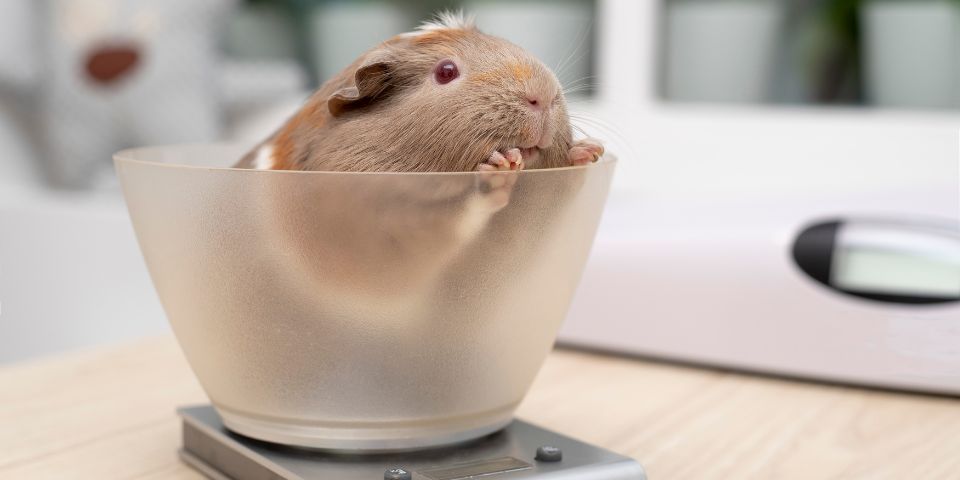Author: Kellie Hayden
Updated: Feb 15, 2024
How do you determine what a “normal” weight is for your small mammal? It’s not necessarily an easy question to answer, as each pet is unique with their own eating habits, metabolism, body shape, and exercise frequency.
Monitoring your pet’s weight can help you and your veterinarian assess whether your pet might not be getting enough exercise, if a diet change might be affecting them, or if they might be losing weight due to a hidden illness. Monitoring weight is especially vital for senior pets, who may be more likely to suffer from health concerns such as arthritis or cancer due to their old age.
In this article, we’ll discuss how to determine your pet’s ideal weight, as well as how to monitor your pet’s weight to ensure they remain happy and healthy.
Finding Your Pet’s Target Weight
To start, work with your trusted veterinarian to determine your pet’s target weight. This is the magic number that your pet should weigh and will ideally remain throughout their adult life. Establishing a target weight can play an integral role in understanding what’s happening with your pet’s health.
Small animals typically are hard-wired to mask illness. In the wild, this helps small animals appear healthy and avoid looking like an easy meal for a predator. But even though our little friends are safely indoors, this instinct remains. As a result, monitoring their weight is an essential tool in your kit for maintaining your pet’s health.
For some help in finding your pet’s target weight, check out our body condition charts. These charts can give you a clear example of what it means for your pet to be over or underweight.

Essential Materials for Monitoring Your Pet’s Weight
Finding a good scale to monitor your pet’s weight doesn’t have to be complicated! What’s important is that it reads accurately and will give consistent readings from one day to the next. Inconsistent readings (or inaccuracies on the scale’s part) make it difficult to understand whether the numbers you’re seeing are the result of an error or are actually revealing a drastic weight change in your pet.
Depending on the size of your pet, a kitchen scale that can measure up to 10 pounds might be ideal. Many pet parents like their pet’s scale to resemble a human scale with a low profile and a platform for the pet to stand on. Make sure the scale can flip between pounds, ounces, and grams.
Once you’ve secured a scale, get a notebook and pen or pencil to keep a record of your pet’s weigh-ins.
While some pets can be trained to patiently stand on a scale, you may find that your pet needs to be contained during weigh-ins. If your pet willingly stands on a scale, you might want to add some kind of non-slip covering to the scale’s platform in order to avoid paws slipping and accidental muscle strains. Other pet parents find that they may need a large bowl to contain their pet during weigh-ins. Whatever method you use, always make sure the scale is tared, or “zeroed out” before your pet is on the scale. This ensures the scale is only recording the weight of your pet and not the additional weight of other materials on the platform.
When weighing your pet, it’s recommended to keep the scale and your pet low to the ground. Even pets who have experienced many weigh-ins may inexplicably decide to jump out of their containment or may startle unexpectedly, possibly resulting in an injury that could have been avoided.

Monitoring Your Pet’s Weight Consistently
The key to monitoring your pet’s weight is to stay consistent with weigh-ins. Work with your veterinarian on how many weigh-ins per week is appropriate for your pet. The answer may change over time based on your pet’s age, health status, diet, and many other factors.
Weigh your pet at a consistent time of day for every weigh-in. Our pets have natural eating and elimination patterns, so weighing in at the same time helps factor out the natural weight fluctuations that happen because of these patterns.
What you should ultimately look for when monitoring your pet’s weight is a consistent change over time. Just like us, our pets will have a small amount of natural weight fluctuation, even with daily digestive rhythms accounted for. How much fluctuation is acceptable is something that should be discussed with your veterinarian, as they are knowledgeable about your pet’s health history and can provide a hands-on physical exam. Depending on a pet’s age and overall health status, one individual may be able to safely handle more weight loss than another.
As you repeat the process of weighing your pet regularly and writing the date and their weight, keep the following questions in mind as you review your pet’s weight record:
- Is your pet consistently losing weight from one weigh-in to the next?
- Is there sudden, unexplained weight gain? Or a major weight loss?
- Can the gains or losses possibly be related to recent changes in diet, daily care, seasonal changes (for senior pets especially), or medications?
- Is your pet leaving some food in their habitat uneaten, or conversely, are they begging for food more than normal?
- Does your pet also have other symptoms manifesting that indicate health issues, such as smaller than normal stools?
If any alarming weight gain or weight loss is documented, reach out to your veterinarian to report your findings. They may want to see your pet for a professional wellness check and look for signs of illness.
